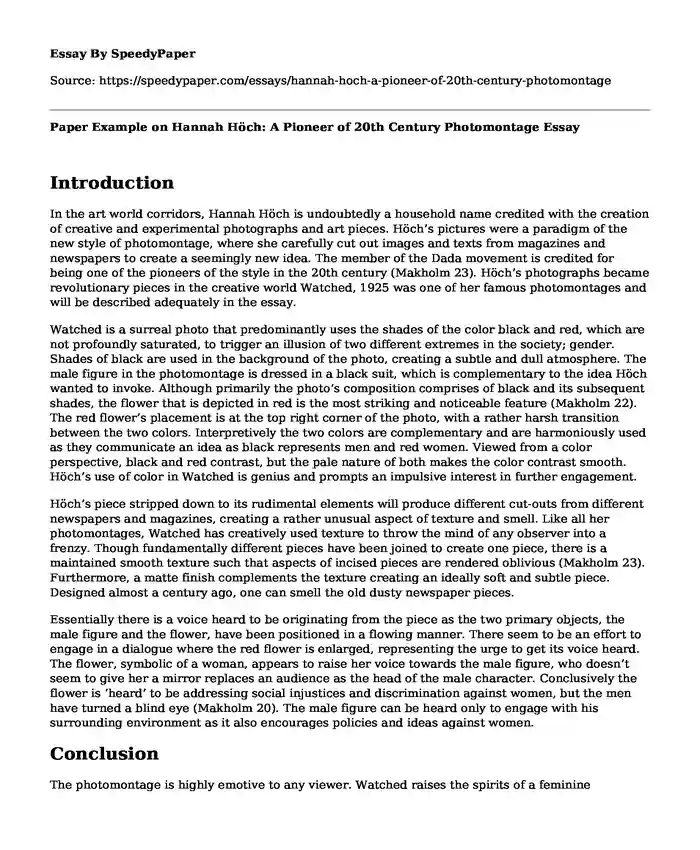Introduction
In the art world corridors, Hannah Höch is undoubtedly a household name credited with the creation of creative and experimental photographs and art pieces. Höch’s pictures were a paradigm of the new style of photomontage, where she carefully cut out images and texts from magazines and newspapers to create a seemingly new idea. The member of the Dada movement is credited for being one of the pioneers of the style in the 20th century (Makholm 23). Höch’s photographs became revolutionary pieces in the creative world Watched, 1925 was one of her famous photomontages and will be described adequately in the essay.
Watched is a surreal photo that predominantly uses the shades of the color black and red, which are not profoundly saturated, to trigger an illusion of two different extremes in the society; gender. Shades of black are used in the background of the photo, creating a subtle and dull atmosphere. The male figure in the photomontage is dressed in a black suit, which is complementary to the idea Höch wanted to invoke. Although primarily the photo’s composition comprises of black and its subsequent shades, the flower that is depicted in red is the most striking and noticeable feature (Makholm 22). The red flower’s placement is at the top right corner of the photo, with a rather harsh transition between the two colors. Interpretively the two colors are complementary and are harmoniously used as they communicate an idea as black represents men and red women. Viewed from a color perspective, black and red contrast, but the pale nature of both makes the color contrast smooth. Höch’s use of color in Watched is genius and prompts an impulsive interest in further engagement.
Höch’s piece stripped down to its rudimental elements will produce different cut-outs from different newspapers and magazines, creating a rather unusual aspect of texture and smell. Like all her photomontages, Watched has creatively used texture to throw the mind of any observer into a frenzy. Though fundamentally different pieces have been joined to create one piece, there is a maintained smooth texture such that aspects of incised pieces are rendered oblivious (Makholm 23). Furthermore, a matte finish complements the texture creating an ideally soft and subtle piece. Designed almost a century ago, one can smell the old dusty newspaper pieces.
Essentially there is a voice heard to be originating from the piece as the two primary objects, the male figure and the flower, have been positioned in a flowing manner. There seem to be an effort to engage in a dialogue where the red flower is enlarged, representing the urge to get its voice heard. The flower, symbolic of a woman, appears to raise her voice towards the male figure, who doesn’t seem to give her a mirror replaces an audience as the head of the male character. Conclusively the flower is ‘heard’ to be addressing social injustices and discrimination against women, but the men have turned a blind eye (Makholm 20). The male figure can be heard only to engage with his surrounding environment as it also encourages policies and ideas against women.
Conclusion
The photomontage is highly emotive to any viewer. Watched raises the spirits of a feminine campaign and calls for equality in society. Aside from creating an empathetic feeling, it invokes the will to advocate for the liberation, acceptance of women, and a paradigm shift of how their view in various communities (Makholm 21). The flower is symbolic of how women are objectively considered and how it is ‘mirrored’ in society, even though they have the abilities and competencies to ‘color’ the world, which is ultimately manifested by the flower’s red color. Watched can capture any observer’s sensory elements and can command response, making it an exemplary art piece.
Work Cited
Kristin Makholm. “Strange Beauty: Hannah Höch and the Photomontage.” MoMA, no. 24, 1997, pp. 19–23. JSTOR, www.jstor.org/stable/4381346. Accessed 25 June 2020
Cite this page
Paper Example on Hannah Hoch: A Pioneer of 20th Century Photomontage. (2023, Sep 15). Retrieved from https://speedypaper.com/essays/hannah-hoch-a-pioneer-of-20th-century-photomontage
Request Removal
If you are the original author of this essay and no longer wish to have it published on the SpeedyPaper website, please click below to request its removal:
- Leonardo da Vinci
- Will.i.am Biography - Free Essay
- Essay Sample Dedicated to Handel's Messiah Hallelujah Chorus
- Paper Example. Formal and Inspirational Parallels Exist between Rhode's and Keith Haring
- Essay Example. Becoming Mexican American by George Sanchez
- Essay Sample on How Does Music Affect a Persons's Knowledge, Aggression, and Demeanor?
- Essay Example: Insights into Meghan Thee Stallion's Life and Music Journey
Popular categories





